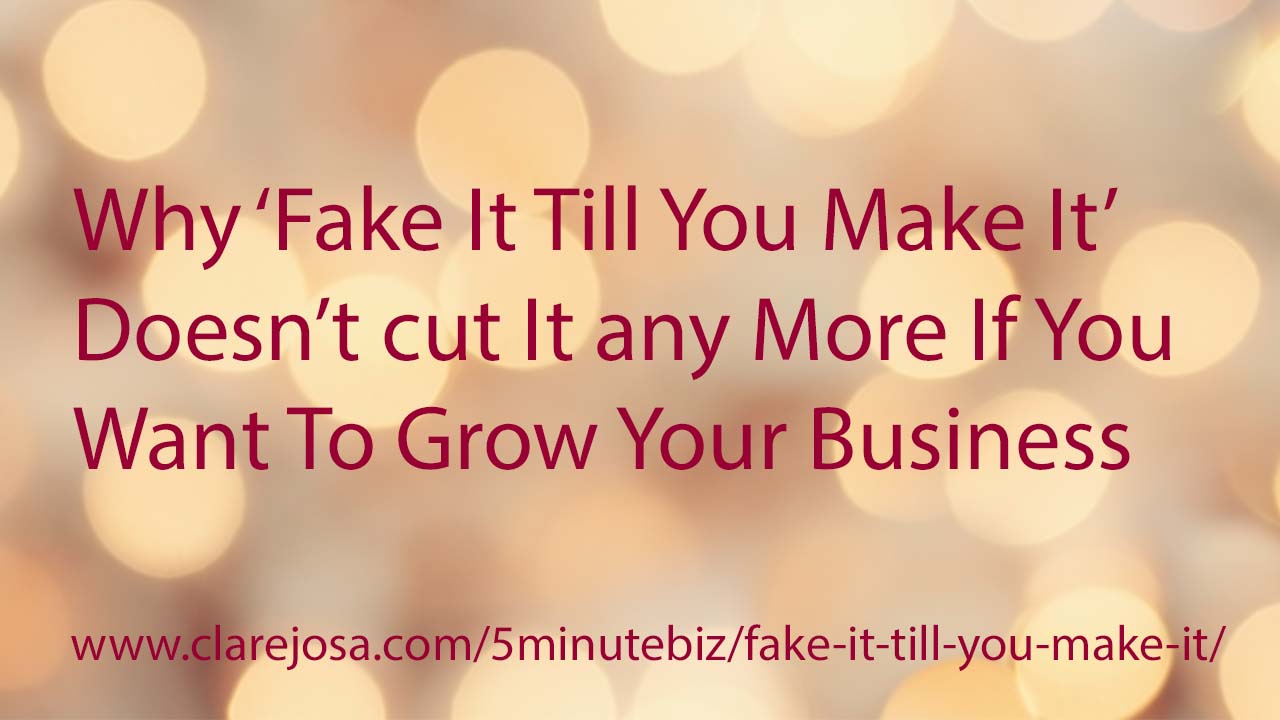Welcome to this week’s Dare To Dream Bigger business podcast episode – all about how to handle customers who are driving you crazy.
Do you ever get customers who drive you mad? Where you’d LOVE to say what you’re really thinking and feeling about them, but you kinda know that’s a fast-track to closing your business? Then catch today’s podcast episode, where I’m sharing with you 5 practical steps and attitudes you can take, to turn a compulsive-complainer into a superfan.
So in today’s podcast, we dive in and explore:
- Why on earth do those crazy customers complain?
- Why does it hit us so hard?
- What’s the ‘step zero’ that each of us should be taking, before we open our inbox?
- 5 practical things you can do, to turn things around
- How weaving these together can even turn a compulsive-complainer into a superfan
Try the ideas on for size today:
[divider line_type=”No Line” custom_height=”22″]
And when you’ve listened to today’s episode, I’d love to know – via the comments:
- How do you handle grumpy customers?
- What might change, having listened to today’s podcast?
- Which of the 5 steps resonated most for you today?
Can’t wait to hear from you!
Liked this? Help spread the word:
DTDB 003 – How To Handle Customers You Secretly Want To Strangle https://t.co/7GvVq6Z7YW #businesspodcast #entrepreneur #startup #dtdb
— Clare Josa (@clare_josa) February 1, 2016
And here’s the course I mentioned, if feeling calmer, less stressed and more grounded is something that would help you: www.daretodreambigger.biz/meditationchallenge
With love, Namaste,
Clare x
Clare Josa, Mentor To Passionate World-Changers
Make sure you catch each episode – plus member-only bonuses:
Prefer the transcript? Here you go!
Hello, and welcome to this week’s episode of the Dare To Dream Bigger business podcast with your host Clare Josa, mentor to passionate world-changers. The show notes for this episode are at DTDBpodcast.biz/003.
Today, we are talking about how to handle the customers you secretly want to strangle. We’ve all had them. They’re the kind of people who, whenever you open your inbox on your customer service email and you see there’s on in there from them, your heart sinks. At best, it drags you down a bit and it puts a damper on your day. At worst, it can send you completely off track. It can detach you from your inspiration, and it can even make you question why you’re running your business in the first place.
Now, I’ve been running my business since 2002, and I’m pleased to say I don’t get that many angry customers, but I do get some that make me pull my hair out, and I do get some where, in the olden days, they used to really knock me out of kilter. They used to really derail me from my passion. And I used to find that, for a day or two, or even longer after I’ve had to deal with them, it was really, really hard to get back in my flow. And, there were a couple that made me really doubt why I was doing what I was doing.
You see, the thing is for somebody to actually contact you to complain, they have to be pretty peed off, yeah? The vast majority of people don’t actually take action. They’d rather just sit around at home and grumble and complain to their friends and loved ones. Or, worse still these days, go public about it on social media trying to humiliate and annoy you. But, most people won’t even do that. Most people just fester in their head. So, by the time somebody reaches your inbox or your social media feed with a grump, they’ve probably been winding themselves up for a while.
What you’re on the receiving end of is all of those mind stories they’ve been telling themselves for days or even weeks. You suddenly get it like a bolt out of the blue with all of that angst, all of that anger, all of that projected stress and dissatisfaction, and you’ve got to deal with it.
What I want to cover in today’s podcast is some practical ways that you can handle this, some ways you can keep your energy clean so you don’t have to take on their anger monkeys, and five different things that you can do, beliefs you can try on, to help you handle that kind of customer more effectively and also make sure you’ve got crystal clear, but compassionate boundaries.
I’ve been an NLP trainer since 2003, and one of the things that leading transformational workshops has taught me is, when people are close to a transformation, the ego mind, the bit that tells us the stories, the inner critic goes wild. It feels terrified. It’s looking for something to lash out at and, nine times out of ten, they lash out at things like the accommodation at the venue or the quality of the lunch because they can’t lash out at themselves.
When I run online summits, programs, and courses, you’ll find that people, because they don’t have a venue to lash out at, it’ll be something about the format of the pages or the sequence on the log-on. They find things to criticize because they’re feeling an internal fear that they’re about to change and they need to project that to somebody else because it’s easier than looking in the mirror. Most of the time it’s unconscious.
I kind of made myself a promise a decade ago that I will never run a retreat center. There’s just no way I could run the courses and also handle people complaining about the towels, but this is what happens.
When they reach your inbox and they’re venting their spleen, it’s usually not because you’ve actually done something wrong. Sure, if there might be something in your process that could be improved, or you might have over-promised on your sales page, in which case you need to take action. But, nine times out of ten, it’s not about you. It’s about them. In this world of online anonymity, it’s easier to send an angry email to a stranger than to look in a mirror and say, “I’m feeling angry. I’m going to deal with that.”
Point one I want to cover with you today is at that point zero, before you even open your customer service inbox, you need to get yourself into a good space because the likelihood is it’s actually going to be full of people with very calm inquiries and even positive feedback that can lift your day. But, just in case there’s a howler in there, you can imagine yourself doing one of my favorite self-preservation things.
Imagine you’re inside a glittery disco ball, and it’s one of those little ones covered in mirrors. The mirrors on the outside of that energetic disco ball–try this on for size. I know it sounds weird–the mirrors reflect back to the sender anything that is not born from love or intended for your growth. It reflects that energy straight back.
Similarly, it’s got mirrors on the inside. So, if you feel tempted to go back with a rant to that customer, it reflects it back to you so that you don’t. Get in your mirror ball first before you open the emails. That is point zero.
Then step number one is a rule in the training world that I learned many, many years ago. If there is a conceivable way to misunderstand the instructions on something, no matter how simple and clear you’ve made it, somebody will manage. Now, if somebody comes to you having a whinge that they can’t work out how to log in, they can’t work out how to find something, the link isn’t quite working the way they want it to, how about reframing this as a positive? The fact is, they care enough about accessing your product that they’re prepared to write to you to get help. You might want to strangle them and say, “It’s so simple.” Well, it is for you, but clearly for them it hasn’t been.
If you can move yourself to a place of compassion and maybe you might need to make some changes to your process, you might need to change the wording in an email, you might need to look at what you phrased on a sales page, there could be something useful in there. But, if they genuinely can’t do what you’re asking them to do, that’s not going to go away just because it annoys you. Ask them to get specific about what they’re stuck on, help them, and then see if there’s a way you can improve your processes to mean that people don’t need to contact you about that next time.
Number two is to manage your state and don’t do the drama. So many people these days are up for a fight. They’re stressed. They’re fed up. They’re harassed. And, as I said already, it’s so much easier to attack a stranger via social media or via the email outbox than it is to look in the mirror and deal with your own pain.
When you reply to this kind of email, it’s your job to be the grownup. They’re behaving like a tantruming toddler. Your job is to be calm, to understand that at some level they’re experiencing pain and anger, but it’s not really about you. You need to reply from that space of how can I reply so I show compassion, but with clear boundaries, which will come onto in a minute, because the worst thing you can do for your customer service is go back with an abrupt reply or with an angry reply or a stupid person reply.
We’ve all seen it where people copy and paste and screenshot emails they get from big companies, which are emails that should never really have been sent. When you are your brand, every communication you send out there, you are brand ambassador. Even if you have a customer who is being completely unreasonable, you need to take out the emotion from your reply.
That brings me on to point number three, which is what is real in this. You’ve got their rant in front of you, and it’s hit all your buttons, whether you’re imagining being back in front of the headmaster’s office at school or being told off by your parents or all those years of self-talk of I’m not good enough. It hits every button you’ve got, and these people don’t realize how painful it is to be so aggressively communicated with. They’re not thinking about that. They’re coming from their pain.
Before you reply, ask yourself what is real in this and what is projection. What are the actual facts? Specifically, what is the problem and what is the solution that I can offer to help this person? Bearing in mind some people don’t want to be helped. Sometimes you go back saying, “Actually, all you need to do is this,” and you just get back a string of excuses. They just needed to vent their spleen.
But, the best way for you to take the emotion and the drama out of the situation is to take a step back. You might even want to imagine you’re standing under a waterfall to wash you clear of all the sludge of emotion that is in that email. Then reply to the facts of the situation calmly and compassionately without patronizing them and without returning the aggression.
Point number four, I love this. This really helps me when I really, really want to strangle somebody. Please, if you’re one of my customers, it’s really, really, really rare for me to want to strangle anyone, but occasionally when somebody really needs a bit more love and it arrives in my inbox, the first reaction for most of us is, “I can’t believe they just sent that to me.” Yeah? I love you. Really, I love you.
This saying has helped me in so many of my mentoring clients over the decade. It’s a Native American Indian saying. “All criticism is born of someone else’s pain.” Now, if you get that howler in your inbox, it’s not about you. There might be a problem you need to fix, but the anger and the emotions they’re projecting to you are from inside them. It’s pain that they are feeling.
Happy people don’t criticize like that. Happy people send emails that say, “Hey, I can’t work out how to log in. Could you help me, please? And I’m really loving this course.” Happy people don’t come back telling you that you’re stupid, that you’re an idiot. They don’t send out rage.
If you’re on the receiving end of an email from a customer, or you’ve seen something going on social media from a customer, and they’re venting their spleen, it’s because their spleen is in pain. All criticism is born of someone else’s pain. It’s not really about you. It’s about them. That helps you get to a place of compassion and then replying to the facts of the matter rather than the emotions and the drama can diffuse the situation really quickly.
That then brings me on to point five, which is you have to have crystal clear boundaries. If the services and products you’re offering are being correctly described on your registration pages, and you’re being fair and truthful, and honest and authentic, then the chances of somebody having a genuine complaint against you are extremely, extremely low. It’s much more likely that they’re on that cusp of change or transformation, and they need someone to lash out at. If trying to help somebody compassionately, dealing with the facts, not the drama and the emotions, if that’s not working, it is okay to say no. It is okay to have crystal clear boundaries. In fact, it’s essential.
Now, I’ve got three young boys, and the toddler phase is still very fresh in my memory for all three of them, even though my eldest is now 11. One of the things they taught me is you have to have boundaries. You have to have a walkaway point.
Think about it. Actually have plans. What kind of customer service do I want to deliver, and what would be going too far, because people will try? If they need this reaction from you, they will try and push you beyond your boundaries. You need to be clear about is this a reasonable request.
Frankly, the fallback option is simply refund the customer and take them off your list. Yeah? Sometimes people’s products and services come with guarantees. Sometimes they don’t. I am a member of a Facebook business group for entrepreneurial women, and there was a discussion going on in there a couple of weeks ago about a very high-end program that somebody had bought. I won’t mention any topics, but this person felt hugely disappointed that it had been oversold and under-delivered, and it was a very, very expensive program, and it was, frankly, not up to standard.
They’d gone back to the person who’d sold it to them. Sure, there wasn’t a guarantee, but they said, “Look. You promised this. You’re not delivering it.” They were quite clear and calm. In fact, this time it was actually the business owner who needed strangling because the business owner said, “Tough. I don’t have a guarantee. Go away.” The customer actually had to get their lawyer involved, and the business owner came back with the same response.
Now, the correct and decent and courageous and compassionate response would have been either to try and fix the problem or to say, “Okay. It wasn’t for you. I don’t normally do a refund policy, but, in this situation, I’ll make an exception.”
What’s happened, because this business owner came back with aggression, the whole of that group with thousands of entrepreneurs now knows that that program is not worth the money that’s being charged and that that person is an aggressive behavior, potentially fraud. The damage done to their business is enormous. So, it’s really important to have boundaries. If you can’t fix something, refund. If you’ve got a customer who can’t behave reasonably, take them off your list. Most systems have a way of blocking people so they can’t sign up again. The fact is you don’t have to be the receiving end for their stress or frustration or anger.
There’s one final thing I’d like to say on those steps is very often when I’ve had somebody come to me who maybe I was tempted to react strongly towards because they’d pressed my buttons, when I’ve managed to be able to follow these five steps, they so often turn into super fans because you break the habit for them. You break that pattern. You help them feel important. You help them feel like they’re valued, and you helped them.
We’re all in this because we want to make a difference, and each life you can make a difference in is so worthwhile. You never know where that might lead. So, sometimes, if somebody comes on social media and they’re having a whinge because they can’t work out how to do something on the tech side of one of my courses, instead of wishing I could delete the tweets, my team and I use it as an opportunity, where we can, to show the excellent standard of our customer service, that we’re professional, that we’re calm, that we’re compassionate, and that we’re supportive. But, we also use it to demonstrate our boundaries. Sometimes my most annoying customers have turned into my super fans simply because of the way we handled their complaints. There can be a positive side.
Also, these howlers in your inbox, they can show you the bits that are broken in your processes. They can show you the things that need simplifying to allow you to have even more happy customers in the future, so there can be hidden gifts inside.
The biggest thing I would say to you is the happier and more grounded you are in yourself, the less these howlers and complaints and stress points will bother you. If you’re high as a kite, absolutely exhausted, if your adrenals are running high, you’re going to be using the fight or flight part of your nervous system, the sympathetic nervous system. You’re going to be working from the amygdala, the reptilian part of the brain that doesn’t think about long-term consequences.
It’s in survival mode, and it is going to treat that customer as though it were a saber tooth tiger. We can all imagine where that might end up. Nobody likes to get a reply to an angry email being treated like they’re a saber tooth tiger on the attack. If you can get yourself grounded, and you can spend most of your time in flow, and you can really make it a priority to manage your internal state to focus on things like gratitude, maybe even to take up meditation, you’ll find that that email doesn’t bother you anymore.
I had one this morning, which is what prompted me to write this podcast, from somebody who decided it was too difficult to click the unsubscribe button on a free summit that I’m running and that they wanted to abuse, instead. A few years ago, that would have knocked me for six. I’m recording the next live master class this morning. It would have hit my state for the whole day. It would potentially have derailed that master class. Because I’ve spent so much time on my inner state, and I was able to apply the five steps I’ve talked to you in the podcast today, yeah, I still find it really sad that this person needs to behave aggressively, but I can really feel it’s not about me, and actually it’s not about the program that we’re all running at the moment. It’s about pain coming from inside, and that’s okay.
It’s really not nice to have received that level of aggression this morning, but I know it’s also not real. It’s nothing that we’ve actually done. You never know what’s happened to somebody. They could have had a row with their partner. They could have crashed their car that morning. They could have just lost their job. Their favorite pet could have just died, or they could just be a generally grumpy and angry person.
It’s not up to us to second-guess. It’s up to us to remember that they’re just human and they don’t have the knowledge we do, so they might misunderstand our instructions. It’s up to us not to dive into the drama. It’s up to us to respond to the facts, not the emotions, to remember that all criticism is born of someone else’s pain, and to have crystal clear, compassionate boundaries.
I hope that’s really helped you today on some practical ways to handle the customers you secretly want to strangle. If you want to learn to meditate, I do actually run a hugely popular online course, a 28-day program called The 28 Day Meditation Challenge. You can find that at the show notes here, DTDBpodcast.biz/003 and at www.DareToDreamBigger.biz/meditationchallenge.
I’d love to hear from you via the comments. What do you do when you get contact from a customer that you’d really secretly like to strangle? Which of the steps today could you implement? Can you see how maybe sometimes you are making things worse by reacting the way that you do? And, what could you do to train your team and anybody else who connects with your customers on your behalf to handle this kind of thing in a way that could turn these people from complainers into super fans? I’d love to hear from you via the comments.
I’ll be back next week with Episode 004. Clare Josa signing off from the Dare To Dream Bigger business podcast. I hope you have a fantastic week.








